Curiosity Rover Breaks Mission Record, Snaps Selfie To Celebrate
NASA’s Curiosity rover has just reached an important milestone. After nearly seven years of trekking the red planet, the six-wheeled robot has stumbled upon a cache of clay minerals larger than anything detected in all of its years on Mars.
The momentous discovery was made on the slope of Mount Sharp – the 3.4-mile-high mountain rising in the middle of the 96-mile-wide Gale Crater – in an area known as the “clay-bearing unit.” This particular region lies south of Vera Rubin Ridge, the rocky outcrop that Curiosity studied for more than a year before moving to its current location. After recently drilling in two different spots within the “clay-bearing unit,” the Mars rover walked away with more clay minerals than ever before, NASA’s Jet Propulsion Laboratory (JPL) in Pasadena, California, announced today.
The drilled samples were gathered from two different rock targets that served as Curiosity’s 20th and 21st drill sites and which go by the names of “Aberlady” and “Kilmarie.” As The Inquisitr previously reported, the intrepid Mars explorer has been investigating “Aberlady” since April, when it first bored into the now-famous slab of rock and managed to snag its first-ever drilled sample since arriving at the “clay-baring unit.
It appears that the decision to pick “Aberlady” as a drill target was an inspired one, as the rock – together with the nearby “Kilmarie” rock – ended up yielding “the highest amounts of clay minerals ever found during the mission,” revealed the JPL.
According to the JPL, NASA has had its sights on the “clay-bearing unit” for a long time, even before Curiosity landed in the Gale Crater of Mars in August of 2012. Located on the side of lower Mount Sharp, this clay-enriched region holds great potential in unraveling important clues about Mars’ past habitability conditions.
“Clay often forms in water, which is essential for life; Curiosity is exploring Mount Sharp to see if it had the conditions to support life billions of years ago.”
After storing the drilled samples in its internal laboratory, Curiosity analyzed the material with the help of its CheMin chemistry and mineralogy instrument. The analysis uncovered only small traces of hematite, an iron oxide mineral that the rover has found in abundance on Vera Rubin Ridge.
The finding adds to the proof that Mars’ Gale Crater was once covered in water, notes the JPL, which manages the Curiosity mission for NASA.
“It’s likely that the rocks in the area formed as layers of mud in ancient lakes — something Curiosity also found lower on Mount Sharp. Water interacted with sediment over time, leaving an abundance of clay in the rocks there.”
To celebrate the record-breaking find, Curiosity took a moment to snap a festive selfie – one that also captured a bit of the “clay-bearing unit,” including “Aberlady” and “Kilmarie.” Taken on May 12 – a.k.a. Sol 2405 of the Curiosity Mars mission – the new photo shows the two drill targets as tiny holes located just to the left of the rover’s wheels.
Meanwhile, back on #Mars…
I’ve found the highest amounts of clay minerals ever during my mission and then snapped this selfie.
More about the science: https://t.co/FpYPKMspwq
How I take selfies: https://t.co/T8dOY1hjhF pic.twitter.com/OYFUDPpiw1— Curiosity Rover (@MarsCuriosity) May 29, 2019
As the JPL points out, the selfie is a composite image pieced together from 57 individual photos taken by Curiosity’s MAHLI camera, located on rover’s robotic arm. The images were stitched together into a panorama, and the robotic arm was digitally removed from the picture.
Aside from snapping this lovely self-portrait, Curiosity also cast its inquisitive eye on the sky on three separate occasions – May 7, May 12, and May 17 – and photographed water-ice clouds floating over Gale Crater at about 19 miles above the surface of Mars.

“They are also ‘noctilucent’ clouds, meaning they are so high that they are still illuminated by the sun, even when it’s night at Mars’ surface,” explained the JPL.









